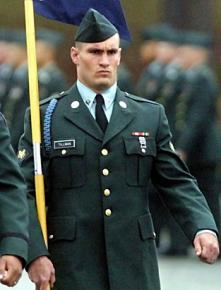What happened to Pat Tillman?
reviews a new book that tells the story behind the death of NFL star and soldier Pat Tillman, who was killed in Afghanistan.
JON KRAKAUER'S best-selling true story Into the Wild and the subsequent film by the same title introduced the world to an insatiable young man who dies young in search of fulfillment, challenge and the key to happiness. His latest work follows a similar line, but in this case, the subject needs no introduction.
In Where Men Win Glory: The Odyssey of Pat Tillman, Krakauer parses the truth from the reams of lies, distortions and carefully worded half-truths surrounding the NFL athlete who became the U.S. Army's most famous recruit.
Depending on how it served their public relations needs, the Pentagon and White House carefully disseminated and censored everything from Tillman's decision to enlist in 2002 to the circumstances surrounding his death in Afghanistan in late April 2004.
To hear CNN's version of the story, Tillman was a selfless patriot who left behind the fortunes and comforts of a professional football career in order to serve--and ultimately pay with his life--in defense of his country, its freedoms, etc. Left at that, the story was useful for proponents of the wars in Iraq and Afghanistan, particularly at the time of Tillman's death.
In April of 2004, resistance to both occupations persisted, highlighted by the Falluja revolt and exacerbated by the Abu Ghraib torture scandal. For a White House concerned with growing opposition in an election year, Tillman's all-American story of patriotic service would become the antidote, despite the fact that Tillman explicitly requested not to be paraded through the streets. But a nationally televised funeral service would be just one of the dishonors committed against Tillman.
THE CRIMES enumerated in Krakauer's book include the suppression of the actual cause of Tillman's death (fratricide), the fabrication of sworn testimonies to posthumously bestow Tillman a Silver Star and, perhaps most consequentially, the exploitation of his character to justify wars he increasingly opposed.
Krakauer's research produces a compelling recital of the battle that led to Tillman's death. It's an evocative and sympathetic portrait of Tillman and his fellow Army Rangers in Afghanistan.
The tension builds as sundown approaches and Tillman's unit finds itself split in two because the commanding officers obstinately refuse to let them abandon or destroy a broken-down vehicle. With the help of a local person, they sluggishly tow the vehicle through a narrow, craggy valley as the tangible threat of attack from above grows. Once that attack begins, the scene unfolds into the chaos of battle culminating in half of the unit firing on the other.
On the one hand, Krakauer's description makes fratricide appear inevitable in these wars--an embarrassing reality for the Pentagon. But given the lengths that the authorities went to cover up the incident, Krakauer also leaves us believing that such accidents are vastly undercounted. Most families don't have the Tillmans' profile and the emotional wherewithal to publicly challenge the military's official stories.
Most importantly, the book handily exposes the Bush administration's exploitation of soldiers to justify the pursuit of war. Krakauer explains that Tillman was among the more than 1,000 troops sent in to "rescue" Pfc. Jessica Lynch from Iraqi "captivity" just days into the invasion of Iraq.
The Pentagon's story conveniently left out the fact that Iraqis took good care of Lynch and even tried to deliver her to American forces in an ambulance--only to be fired upon. At the time, Tillman wrote in his diary that, given the scale of the operation and the military's desperation for good news, the mission smelled like a publicity stunt.
He was right. And one year later, his own death would become one too.
In the days after Tillman's death by friendly fire, those who fought alongside him were prohibited from speaking about the circumstances surrounding the incident. Hundreds of e-mails circulated among White House and Pentagon officials figuring out how best to leak their own version of the story to best suit their needs.
Just days earlier, the gruesome photos of torture taking place at Abu Ghraib prison were revealed in the press, and the administration calculated that a dramatized, carefully censored version of Tillman's death could grab enough headlines to compete with the bad press. Tillman's best military friend was briefed and, unknowingly, his nationally broadcast eulogy contained much of the misinformation that Krakauer's research, as well as that of Tillman's family, exposes.
Whereas the Pentagon--headed by the now-disgraced Donald Rumsfeld and parroted by the forever-disgraceful Ann Coulter--exploited Tillman's enlistment and death, Krakauer's book is a testament to Tillman's formidable character, particularly his socially progressive politics.
Krakauer describes Tillman's opposition to the homophobia he encountered throughout his football career, his strong distrust of George Bush and his increasingly doubtful approach to the missions being carried out in Iraq and Afghanistan. Perhaps most tellingly, just months before his death, through a former college classmate, Tillman initiated correspondence with Noam Chomsky, whose writings were helping Tillman make sense of the wars he was fighting.
Krakauer himself follows Tillman's critical lead by spending much of the book's early pages contextualizing the invasion and occupation of Afghanistan with the sordid back-story of U.S. and Russian imperial meddling in that country.
Readers who come to this biography expecting a confirmation of the story popularized by the mainstream media will be surprised to learn, among other things, that those who attempted to bring down the World Trade Center in 1993 learned how to make their bombs from the CIA.
In that respect, Krakauer's is a subversive book--as the truth always is to those who subvert it.



